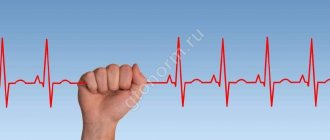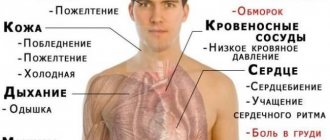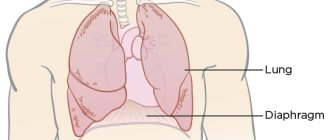Shortness of breath (dyspnea) is a painful feeling of lack of air, in extreme terms taking the form of suffocation.
If shortness of breath occurs in a healthy person against the background of physical activity or severe psycho-emotional stress, it is considered physiological. Its cause is the body's increased need for oxygen. In other cases, shortness of breath is caused by some disease and is called pathological.
According to the difficulty of the inhalation or exhalation phase, shortness of breath is distinguished as inspiratory and expiratory, respectively. A variant of mixed shortness of breath with limitation of both phases is also possible.
There are several types of shortness of breath. Dyspnea is considered subjective if the patient feels difficulty breathing, dissatisfaction with inhalation, but this cannot be measured and there are no factors for its occurrence. Most often it is a symptom of hysteria, neurosis, and thoracic radiculitis. Objective shortness of breath is characterized by a violation of the frequency, depth of breathing, duration of inhalation or exhalation, as well as increased work of the respiratory muscles.
Diseases associated with shortness of breath
In diseases of the respiratory system, shortness of breath may be the result of an obstruction in the airways or a decrease in the respiratory surface area of the lungs.
An obstruction in the upper respiratory tract (foreign body, tumor, accumulation of sputum) makes it difficult to inhale and pass air to the lungs, thereby causing inspiratory dyspnea. Reducing the lumen of the final sections of the bronchial tree - bronchioles, small bronchi due to inflammatory edema or spasm of their smooth muscles prevents exhalation, causing expiratory shortness of breath. In the case of narrowing of the trachea or large bronchus, shortness of breath takes on a mixed character, which is associated with the limitation of both phases of the respiratory act.
Mixed shortness of breath will also be due to inflammation of the lung parenchyma (pneumonia), atelectasis, tuberculosis, actinomycosis (fungal infection), silicosis, pulmonary infarction or compression from the outside by air, fluid in the pleural cavity (with hydrothorax, pneumothorax). Severe mixed shortness of breath up to suffocation is observed with pulmonary embolism. The patient takes a forced sitting position with support on his hands. Choking in the form of a sudden attack is a symptom of asthma, bronchial or cardiac.
With pleurisy, breathing becomes shallow and painful; a similar picture is observed with chest injuries and inflammation of the intercostal nerves, damage to the respiratory muscles (with poliomyelitis, paralysis, myasthenia gravis).
Shortness of breath in heart disease is a fairly common and diagnostically significant symptom. The cause of shortness of breath here is a weakening of the pumping function of the left ventricle and stagnation of blood in the pulmonary circulation.
The severity of heart failure can be judged by the degree of shortness of breath. At the initial stage, shortness of breath appears during physical activity: climbing stairs more than 2-3 floors, walking uphill, against the wind, moving at a fast pace. As the disease progresses, it becomes difficult to breathe even with slight exertion, when talking, eating, walking at a calm pace, or lying horizontally. In the severe stage of the disease, shortness of breath occurs even with minimal exertion and any actions, such as getting out of bed, moving around the apartment, bending the body, entail a feeling of lack of air. In the final stage, shortness of breath is present even at rest.
Attacks of severe shortness of breath, suffocation that occur after physical, psycho-emotional stress or suddenly, often at night, during sleep are called cardiac asthma. The patient is in a forced sitting position. Breathing becomes noisy, bubbling, audible at a distance. The release of foamy sputum may be observed, which indicates the onset of pulmonary edema; the participation of auxiliary muscles in the act of breathing and retraction of the intercostal spaces are noticeable to the naked eye.
In addition, shortness of breath in combination with chest pain, palpitations, and interruptions in cardiac function can be a sign of acute myocardial infarction, rhythm disturbances (paroxysmal tachycardia, atrial fibrillation) and is caused by a sharp decrease in heart function, a decrease in perfusion and oxygen supply to organs and tissues.
A group of blood diseases, one of the symptoms of which is shortness of breath, includes anemia and leukemia (tumor diseases). Both are characterized by a decrease in the level of hemoglobin and red blood cells, the main role of which is oxygen transport. Accordingly, oxygenation of organs and tissues deteriorates. A compensatory reaction occurs, the frequency and depth of breathing increases - thereby the body begins to consume more oxygen from the environment per unit of time.
The simplest and most reliable method for diagnosing these conditions is a general blood test.
Another group is endocrine (thyrotoxicosis, diabetes mellitus) and hormonally active diseases (obesity).
With thyrotoxicosis, the thyroid gland produces an excess amount of hormones, under the influence of which all metabolic processes are accelerated, metabolism and oxygen consumption increase. Here, shortness of breath, as with anemia, is compensatory in nature. In addition, high levels of T3 and T4 increase the work of the heart, contributing to rhythm disturbances such as paroxysmal tachycardia, atrial fibrillation with the consequences mentioned above.
Shortness of breath in diabetes mellitus can be considered a consequence of diabetic microangiopathy, leading to impaired trophism and oxygen starvation of cells and tissues. The second link is kidney damage - diabetic nephropathy. The kidneys produce the hematopoietic factor erythropoietin, and its deficiency causes anemia.
With obesity, as a result of the deposition of adipose tissue in the internal organs, the work of the heart and lungs is hampered, and the excursion of the diaphragm is limited. In addition, obesity is often accompanied by atherosclerosis and hypertension, which also entails disruption of their function and the occurrence of shortness of breath.
Shortness of breath to the point of suffocation can be observed with various types of systemic poisoning. The mechanism of its development includes an increase in the permeability of the vascular wall at the microcirculatory level and toxic pulmonary edema, as well as direct damage to the heart with disruption of its function and stagnation of blood in the pulmonary circulation.
1.What is shortness of breath?
Shortness of breath (dyspnea)
is a subjective state characterized by dissatisfaction with breathing against the background of its intensification. Various breathing problems can occur with many diseases. However, the term “shortness of breath” refers specifically to the feeling that even rapid breathing does not compensate for the lack of air.
The subjective psychological perception of this phenomenon is always negatively colored; the vital fear it evokes is associated with the inability to control this process and available ways to alleviate one’s condition. Sometimes a feeling of shortness of breath can occur against the background of objectively completely normal breathing parameters (its rhythm, depth and frequency).
A must read! Help with treatment and hospitalization!
Treatment of patients with shortness of breath
If an elderly patient experiences or worsens shortness of breath when walking, doctors prescribe treatment depending on the cause of the respiratory dysfunction. When treating shortness of breath that occurs or worsens during emotional stress, psychotherapists use an integrated approach using psychotherapeutic, medicinal, and physiotherapeutic techniques and measures.
If elderly people have shortness of breath caused by anemia, therapists provide individually selected therapy. When the hemoglobin level is 109-90 g/l, hematocrit 27-32%, a diet is prescribed, including iron-rich foods, salts, polysaccharide compounds of divalent iron, iron (III)-hydroxide polymaltose complex. If the hemoglobin level is below 90 g/l, the hematocrit is below 27%, a hematologist is consulted, and salt or polysaccharide compounds of divalent iron or iron (III)-hydroxide polymaltose complex are prescribed in a standard dosage. In addition to previous therapy, iron (III)-hydroxide polymaltose complex or iron III dextran is administered intravenously. Patients with severe anemic and circulatory-hypoxic syndromes are given infusions of leukofiltered erythrocyte suspension.
If the cause of severe shortness of breath when walking is heart failure, the following medications are prescribed:
- Angiotensin-converting enzyme inhibitors;
- β-blockers;
- Aldosterone receptor antagonists;
- Diuretics;
- Cardiac glycosides;
- Angiotensin II receptor antagonists.
Patients whose cause of shortness of breath, which worsens when walking, is bronchial asthma, are prescribed drugs that dilate the bronchi by reducing the tone of the smooth muscles of the bronchi, and improve bronchial patency by reducing inflammation of the airway wall.
If you are concerned about severe shortness of breath and palpitations when walking, make an appointment with a therapist online or by calling the contact center. After determining the cause of shortness of breath, the doctor will individually select the most effective drugs to restore respiratory function.
Edema and heart failure
Edema is not always a sign of heart failure. Their most common cause is peripheral venous insufficiency. Due to the expansion of the veins and the incompetence of the venous valves, the blood does not overcome gravity well (it is difficult to climb up the veins of the legs), stagnates in the legs and part of the plasma goes into the tissues. Such swelling is treated with compression hosiery, venotonic drugs, and in severe cases - with surgical methods.
There are still many causes of edema, so if you do not have obvious heart disease, but edema appears, first be examined by a competent therapist.
The main causes of edema:
- Peripheral venous insufficiency
- Lymphostasis
- Taking calcium antagonists, oral contraceptives, non-steroidal anti-inflammatory drugs
- Heart failure
- Liver diseases (liver cirrhosis)
- Kidney disease (severe renal failure)
- Compression of large vessels by the tumor
- Idiopathic edema
I’ll write separately about swelling on the face, which is very frightening for women and which for some reason is popularly considered “renal.” In fact, this is most often a purely cosmetic problem rather than a disease. There is fatty tissue around the eyes that reacts to changes in the amount of fluid around and accumulates water very well. With excessive consumption of salt and liquid, there is a slight increase in the volume of this periocular tissue. In this case, you just don’t need to eat salty foods or drink a lot at night.
Pheochromocytoma - sweating due to adrenal tumors
Pheochromocytoma is a tumor of the adrenal gland that stimulates the production of catecholamines - adrenaline and norepinephrine. The disease is characterized by crises, during which panic attacks, tachycardia, nausea, gag reflex, and increased sweating are observed.
The attack is impossible not to notice, because it is accompanied by impaired cerebral circulation, trembling in the body and pulmonary edema. It lasts 2-3 minutes, but is extremely stressful for a person.
In the absence of an adrenal tumor, an increase in catecholamines is caused by heart disease, alcohol withdrawal, and refusal to take certain medications.
4.Prevention of shortness of breath
Shortness of breath is often a harmless phenomenon and passes without special measures. However, you need to be attentive to this symptom if it repeats too often, and especially during those loads that previously passed without difficulty breathing. The occurrence of shortness of breath during movement in some cases can be a sign of serious disorders in the body. If you are sure that you are healthy, but your breathing is still impaired with increasing physical activity, there may be a number of reasons for this that you should try to eliminate on your own:
- reduce weight;
- lead a more active lifestyle;
- engage in feasible regular training (swimming, dancing, physical therapy, running);
- increase stress resistance, refuse excess information;
- take measures to increase immunity;
- quit smoking.
Malignant and benign tumors
The center of thermoregulation is the hypothalamus, and tumors of any nature in this area cause hyperhidrosis. Sweating especially increases at night, regardless of the temperature in the room.
If this happens without explanation, then the following diseases can be assumed:
- histiocytic lymphoma (malignant lesion of lymphoid tissues);
- lymphocytic lymphoma (oncological damage to the lymph nodes);
- mixed lymphoma (complex cancer of the lymph nodes);
- Burkitt's lymphoma (malignant tumor of the jaw).
Oncological neoplasms are accompanied not only by hyperhidrosis, but also by sudden weight loss, sleep disturbances, general weakness and fatigue.
Sweating due to infection
The vital activity of viruses and bacteria is accompanied by the production of pyrogens that affect the thermal sensitivity of neurons. During the period of exacerbation of an infectious disease, body temperature always rises significantly, which is why hyperhidrosis occurs. The virus is accompanied by muscle pain and body aches, the bacterial infection is accompanied by a skin rash and general toxicity.
Rheumatism is also infectious in nature. The patient's body temperature is constantly elevated, which causes severe sweating. Damage to joints and connective tissue prevents normal movement, but people sweat as if after intense training.
Syphilis is a sexually transmitted disease that affects the mucous membranes. It is characterized by damage to the nerve roots located along the spine, which is expressed by a local increase in sweating.
Diagnostics
A general urine test will help identify renal pathology. To make a correct diagnosis, a complete history and examination of the cause of shortness of breath are fundamentally important. This will help to establish the factor that provokes this condition without resorting to additional research and analysis. Depending on the initial cause, examinations are carried out:
- X-ray;
- Ultrasound;
- general urine and blood tests to identify pathologies in the kidneys and determine hemoglobin levels.
Return to contents
Ovarian dysfunction
The pathology occurs in every 10th woman of reproductive age. This may be an ovarian cyst, but polycystic disease often occurs - a complex disease in which ovulation does not occur and the follicle begins to grow. Over time, the ovary becomes like a bunch of grapes due to the many cysts that form.
Hormonal imbalance and lack of female sex hormones lead to increased production of testosterone, the male sex hormone. It increases metabolism, causing increased sweating.
It is also promoted by autonomic disorders, accompanied by irritability, aggressiveness, and sleep disorders. Symptoms of ovarian dysfunction, in addition to sweating, are menstrual irregularities, weight changes, deterioration in health, increased hair growth, etc.
Sweating and central nervous system diseases
The autonomic nervous system is controlled by centers in the medulla oblongata and spinal cord, and the center is located in the hypothalamus. Ganglia, sympathetic nerve ganglia, are located near the spine, and nerve impulses emanating from them travel along nerve fibers to various parts of the body. If there is a disturbance in the functioning of the central nervous system, increased sweating occurs, regardless of the cause of the malfunction.
But this is only a secondary sign, indicating more significant symptoms:
- with Parkinson's disease,
a person's hands and head shake, muscles have increased tone, and their gait changes; - a stroke
is characterized by speech impairment, changes in facial expressions, and severe headache; - with epilepsy,
a person experiences convulsive seizures, during which hyperhidrosis occurs due to severe overexertion; - with a concussion,
loss of consciousness, nausea, and perspiration may appear on the forehead; - injury to the hypothalamus
manifests itself not only by increased sweating, but also by pressure surges, vascular problems, and sleep disturbances; - hormonal changes.
Teenagers tend to sweat a lot. This is due to a sharp hormonal surge, as well as intensive development of the whole organism and an increase in the functioning of most glands. There is nothing pathological about this, but sweating can cause discomfort for a teenager.
Evaluation of patients with shortness of breath
At the first stage of examining an elderly patient with suspected chronic shortness of breath, doctors at the Yusupov Hospital determine which organ system is primarily affected: cardiac, pulmonary, both or neither. If the patient continues to suffer from shortness of breath despite intensive therapy, exclude the presence of a concomitant factor - an emotional reaction to the disease or a deterioration in general physical condition. Elderly patients with chronic cardiopulmonary disease may gradually limit physical activity because shortness of breath is associated with exertion, which leads to subsequent imbalance of the cardiovascular system and further worsens shortness of breath with walking or exercise. An analysis of anamnestic data, the results of a physical examination and plain radiography helps to establish an accurate diagnosis.
For chronic shortness of breath, which worsens in older people when walking, doctors perform first-level tests:
- Detailed general blood test;
- Metabolic indicators;
- Plain radiography of the chest organs;
- Electrocardiography;
- Spirometry;
- Pulse oximetry.
Second-level tests include echocardiography, determination of the level of brain natriuretic peptide, pulmonary function testing, Holter monitoring, and radioisotope research methods. If the diagnosis has not been established, after consultation with specialists, at a meeting of the Expert Council, a decision is made on the safety of performing third-level tests on elderly patients: examination of the cardiovascular system during exercise, bronchoscopy, and lung biopsy.
How and why sweat occurs
The content of the article
When overheated, sweat glands begin to release fluid to the surface of the skin, thereby reducing body temperature. Water-salt balance is needed to maintain a constant level of electrolytes and ions in the intracellular fluid. Blood plasma also has a salt composition, but in a slightly different concentration.
The main regulator of sweating is the hypothalamus, a region of the brain that sends signals to various parts of the endocrine system, in particular the sweat glands.
Thus, with an increase in the concentration of salts in the blood plasma and a decrease in the volume of intercellular fluid (workout, visiting a sauna, staying in the sun), the signal is processed by the hypothalamus, which reacts by creating a feeling of thirst.
When body temperature rises, regardless of whether it is external influence (overheating) or internal processes (fever), thermoreceptors reflexively react to this and signal the hypothalamus. It activates the work of more than 2.5 million sweat glands, and they begin to secrete sweat-fat secretion.
What does increased sweating indicate?
Hyperhidrosis is not always a pathology. Sweating affects obese and overweight people, women in the premenopausal period, and teenagers. There is nothing abnormal about this. Men sweat 2 times more intensely than women, people with African roots have a genetic predisposition to hyperhidrosis, and in summer the intensity of sweating increases regardless of gender and age.
Professional athletes who train 5-6 hours a day, even after taking a shower and completely changing clothes, continue to sweat intensely for some time after physical activity, and this is not a deviation from the norm.
Some people don’t see anything wrong with sweating; it doesn’t irritate them, although those around them suffer from it.
We should talk about pathology when the problem not only interferes with the person who has it, but also affects social connections. Sweat has a rather complex composition, which includes lactic and uric acids, ammonia, and various salts. As a result of exposure to the epidermis, bacteria are activated, which feed on softened keratin particles. This is precisely the reason for the specific vinegar smell of sweat.
In principle, it is enough for a healthy person to regularly change his underwear and take a shower daily so that the unpleasant smell of sweat is not heard. Apocrine glands secrete a substance with an individual odor depending on health, age and fertility.
In unhealthy people, it becomes intense and repulsive to others. Moreover, standard preventive measures (changing underwear, using antiperspirants, showering twice a day) do not bring any results.
Sweating for no apparent reason indicates pathological processes in the body, among which there are life-threatening pathologies. In particular, hyperhidrosis is characteristic of impaired hemostasis - the optimal level of hormones. This happens when there is a malfunction of the hypothalamus, a small area of the brain that controls the endocrine system.
The most famous example of disturbances in the functioning of the hypothalamus is menopause - the attenuation of a woman’s reproductive functions. During this period, the hypothalamus sends incorrect signals, the endocrine systems experience disruption and react with involuntary activation of the sweat glands - the so-called hot flashes.
In addition to menopause, hyperhidrosis occurs in case of other disorders.










